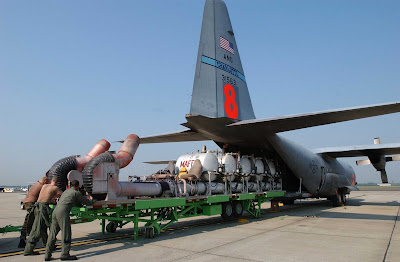 Loadmaster Bill Whitlatch operates a new MAFFS 2 unit aboard a C-130J aircraft Tuesday with the Channel Islands Air National Guard. Photo by Stephen Osman, Ventura County Star.
Loadmaster Bill Whitlatch operates a new MAFFS 2 unit aboard a C-130J aircraft Tuesday with the Channel Islands Air National Guard. Photo by Stephen Osman, Ventura County Star.The U. S. Forest Service has accepted the delivery and started training with two new Mobile Airborne Fire Fighting Systems, MAFFS, which will be used in C-130 aircraft operated by the Air National Guard based at Port Hueneme, California. In development by Aero Union since 2000, the two units are the first of a total of eight new systems, called "MAFFS 2" that should be delivered and ready for firefighting by May. These will replace the older units that have been used for a very long time.
The MAFFS 2 are designed to be rolled into the back of C-130 aircraft and hold

Some of the changes in the design include:
- The nozzles, instead of exiting out the rear loading dock, are routed through a sealed portal (a modified paratrooper door) on the plane's left side. This makes it possible for the plane to be pressurized; in addition, the crew and rear door will no longer be soaked by the retardant.
- The old and new MAFFS use compressed air to pump the retardant out of the tanks. The old system required that the aircraft land to be pressurized by a dedicated air compressor system at a MAFFS base. The new system has on-board air compressors, which will enable the C-130's to reload the retardant at any air tanker base and refill the air tank on the fly, so to speak. It takes 35 minutes to recharge the compressed air tank after a drop.
- The retardant is pumped out under greater pressure and velocity. That feature, and the reconfigured side nozzle will result in a denser stream of retardant which will hopefully penetrate timber canopy better than the original systems. This may make it feasible for the pilots to fly higher and faster, adding an additional margin of safety. Pilots hate flying slow and low over mountainous terrain.
- The new system delivers retardant at twice the coverage rate of the older systems, at "coverage level 8", or 8 gallons of fluid per 100 square feet, which is the maximum required by the U. S. Forest Service.
- There is one report that claims the new system holds 400 more gallons, but that is
not yetnow confirmed. UPDATE: The new single-tank system will hold 3,400 gallons.
There has been heavy criticism during the last 2 years from politicians and others about the inability of the California C-130's to use the MAFFS.
The aircraft can be requested by the U. S. Forest Service after it is confirmed that all commercial air tankers are committed. It takes about 24 hours to configure a C-130 to utilize a MAFFS.
 Photo of an older MAFFS dropping the retardant out of the rear door. Air Force photo, by Staff Sgt. Alex Koenig.
Photo of an older MAFFS dropping the retardant out of the rear door. Air Force photo, by Staff Sgt. Alex Koenig.The U.S. Forest Service has a web site with information about the development of a MAFFS 2 prototype, but it has not been updated since July, 2006.




No comments:
Post a Comment